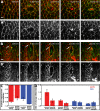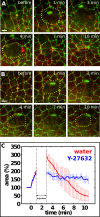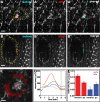Wounded cells drive rapid epidermal repair in the early Drosophila embryo
- PMID: 23985320
- PMCID: PMC3806660
- DOI: 10.1091/mbc.E13-05-0228
Wounded cells drive rapid epidermal repair in the early Drosophila embryo
Abstract
Epithelial tissues are protective barriers that display a remarkable ability to repair wounds. Wound repair is often associated with an accumulation of actin and nonmuscle myosin II around the wound, forming a purse string. The role of actomyosin networks in generating mechanical force during wound repair is not well understood. Here we investigate the mechanisms of force generation during wound repair in the epidermis of early and late Drosophila embryos. We find that wound closure is faster in early embryos, where, in addition to a purse string around the wound, actomyosin networks at the medial cortex of the wounded cells contribute to rapid wound repair. Laser ablation demonstrates that both medial and purse-string actomyosin networks generate contractile force. Quantitative analysis of protein localization dynamics during wound closure indicates that the rapid contraction of medial actomyosin structures during wound repair in early embryos involves disassembly of the actomyosin network. By contrast, actomyosin purse strings in late embryos contract more slowly in a mechanism that involves network condensation. We propose that the combined action of two force-generating structures--a medial actomyosin network and an actomyosin purse string--contributes to the increased efficiency of wound repair in the early embryo.
Figures






Similar articles
-
Tension regulates myosin dynamics during Drosophila embryonic wound repair.J Cell Sci. 2017 Feb 15;130(4):689-696. doi: 10.1242/jcs.196139. J Cell Sci. 2017. PMID: 28202603
-
Wound closure in the lamellipodia of single cells: mediation by actin polymerization in the absence of an actomyosin purse string.Mol Biol Cell. 2002 Mar;13(3):1001-14. doi: 10.1091/mbc.01-04-0167. Mol Biol Cell. 2002. PMID: 11907278 Free PMC article.
-
Wound-induced assembly and closure of an actomyosin purse string in Xenopus oocytes.Curr Biol. 1999 Jun 3;9(11):579-87. doi: 10.1016/s0960-9822(99)80261-9. Curr Biol. 1999. PMID: 10359696
-
Tension (re)builds: Biophysical mechanisms of embryonic wound repair.Mech Dev. 2017 Apr;144(Pt A):43-52. doi: 10.1016/j.mod.2016.11.004. Epub 2016 Dec 15. Mech Dev. 2017. PMID: 27989746 Review.
-
Forceful closure: cytoskeletal networks in embryonic wound repair.Mol Biol Cell. 2019 Jun 1;30(12):1353-1358. doi: 10.1091/mbc.E18-04-0248. Mol Biol Cell. 2019. PMID: 31145669 Free PMC article. Review.
Cited by
-
Collagen, stiffness, and adhesion: the evolutionary basis of vertebrate mechanobiology.Mol Biol Cell. 2020 Aug 1;31(17):1823-1834. doi: 10.1091/mbc.E19-12-0709. Mol Biol Cell. 2020. PMID: 32730166 Free PMC article. Review.
-
Myosin II promotes the anisotropic loss of the apical domain during Drosophila neuroblast ingression.J Cell Biol. 2017 May 1;216(5):1387-1404. doi: 10.1083/jcb.201608038. Epub 2017 Mar 31. J Cell Biol. 2017. PMID: 28363972 Free PMC article.
-
Forces driving epithelial wound healing.Nat Phys. 2014 Sep;10(9):683-690. doi: 10.1038/nphys3040. Nat Phys. 2014. PMID: 27340423 Free PMC article.
-
Diabetic wound regeneration using peptide-modified hydrogels to target re-epithelialization.Proc Natl Acad Sci U S A. 2016 Oct 4;113(40):E5792-E5801. doi: 10.1073/pnas.1612277113. Epub 2016 Sep 19. Proc Natl Acad Sci U S A. 2016. PMID: 27647919 Free PMC article.
-
Actomyosin-Driven Tension at Compartmental Boundaries Orients Cell Division Independently of Cell Geometry In Vivo.Dev Cell. 2018 Dec 17;47(6):727-740.e6. doi: 10.1016/j.devcel.2018.10.029. Epub 2018 Nov 29. Dev Cell. 2018. PMID: 30503752 Free PMC article.
References
-
- Amano M, Ito M, Kimura K, Fukata Y, Chihara K, Nakano T, Matsuura Y, Kaibuchi K. Phosphorylation and activation of myosin by Rho-associated kinase (Rho-kinase) J Biol Chem. 1996;271:20246–20249. - PubMed
-
- Bement WM, Mandato CA, Kirsch MN. Wound-induced assembly and closure of an actomyosin purse string in Xenopus oocytes. Curr Biol. 1999;9:579–587. - PubMed
Publication types
MeSH terms
Substances
LinkOut - more resources
Full Text Sources
Other Literature Sources
Molecular Biology Databases

